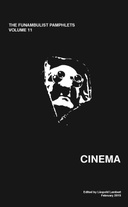Explore

The Funambulist Pamphlets, Vol. 11_Cinema
0 Ungluers have
Faved this Work
Login to Fave
The Funambulist Pamphlets is a series of small books archiving articles published on The Funambulist, collected according to specific themes. These volumes propose a different articulation of texts than the usual chronological one. The first twelve volumes are respectively dedicated to Spinoza, Foucault, Deleuze, Legal Theory, Occupy Wall Street, Palestine, Cruel Designs, Arakawa + Madeline Gins, Science Fiction, Literature, Cinema, and Weaponized Architecture. As new articles are published on The Funambulist, more volumes will be published to continue the series. See all published pamphlets HERE.The Funambulist Pamphlets is published as part of the Documents Initiative imprint of the Center for Transformative Media, Parsons The New School for Design, a transdisciplinary media research initiative bridging design and the social sciences, and dedicated to the exploration of the transformative potential of emerging technologies upon the foundational practices of everyday life across a range of settings.Who are the ‘we’ in this movie? The stubborn director who values ‘history’ more than what is happening in front of him in the present? The venal producer who is finally the most eager to dialogue with the local population while remaining slightly paternalist? The actor playing Christopher Columbus to whom the difficulty of this problem appears very clearly, but who prefers to escape from it by drinking rather than acting? The other actors who value their 15th-century ethical characters but act like cowards when the riots begin? Or can we possibly be somebody else?Vol. 11 is devoted to the topic of Cinema: Spike Lee, Béla Tarr, Michelangelo Antonioni and the many other filmmakers named in this volume do not seem to have much in common at first sight; nevertheless, considered through the interpretation of a Spinozist materialist philosophy, their films might have something to say to one another. Take the mud of Red Desert (Antonioni), the volcanic slopes of The Bad Sleep Well (Kurosawa) and the soil of Pina Bausch’s Rite of Spring magnified in Pina (Wenders), for example. What these material manifestations have in common is that they are all in relation with bodies, themselves assemblages of moving matter. Similarly, consider Spike Lee’s dolly shot, Orson Welles’s labyrinth, Béla Tarr’s entropy, and Peter Watkins’s democratic improvisations: they all manifest the power of immanence and its inexorability. These films involve no deus ex machina; everything in them comes ‘from the ground’ in a continuous refusal of a celestial or other form of transcendence. Developing this kind of reading of these films allows us to avoid a traditional chronological reading of history of cinema in favor of another, one more dedicated to the philosophical vision of the world that cinema triggers.
This book is included in DOAB.
Why read this book? Have your say.
You must be logged in to comment.
Rights Information
Are you the author or publisher of this work? If so, you can claim it as yours by registering as an Unglue.it rights holder.Downloads
This work has been downloaded 258 times via unglue.it ebook links.
- 48 - pdf (CC BY-NC-SA) at OAPEN Library.
- 67 - pdf (CC BY-NC-SA) at Unglue.it.
Keywords
- Architecture
- Cinéma
- Cultural Studies
- Design
- The arts
- thema EDItEUR::A The Arts::AM Architecture::AMA Theory of architecture
- Theory of architecture
Links
DOI: 10.21983/P3.0095.1.00Editions

